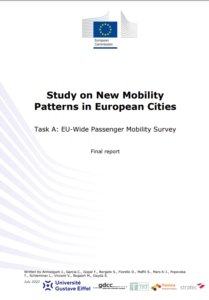HARMONY Model Suite: uno strumento integrato per la pianificazione della mobilità sostenibile a Torino
 TRT is happy to announce the publication of a broad study on new mobility patterns, describing the mobility choices of European citizens and how the urban logistics sector is developing in 16 EU cities. The study, conducted for the European Commission – DG MOVE, was commissioned to collect reliable and extensive data on passenger mobility, urban logistics, fleet composition, transport activity and traffic flows in Member States.
TRT is happy to announce the publication of a broad study on new mobility patterns, describing the mobility choices of European citizens and how the urban logistics sector is developing in 16 EU cities. The study, conducted for the European Commission – DG MOVE, was commissioned to collect reliable and extensive data on passenger mobility, urban logistics, fleet composition, transport activity and traffic flows in Member States.
The passenger mobility survey showed that, on average, EU citizens travelled 27 km per day for an average duration of 80 minutes. The predominant means of transport in 2021 was the car, which was used for almost half of all trips. Excluding trips made by car, walking is the most popular way of moving around in most of the EU, with the Netherlands as a notable exception, where cycling is more popular. New mobility forms are gaining traction: ride-hailing (23%) and ride-sharing (12%) are attracting the most users; however, they are generally used on an occasional basis. The results of the survey were influenced by the COVID-19 pandemic, which affected travel behaviour and restricted travel options. Indeed, 64% of respondents found that the pandemic affected their mobility.
The targeted survey on urban logistics found that companies offering urban deliveries are more likely to own light goods vehicles (57%) than heavy goods vehicles (27%), with the remaining 16% owning both types of vehicles. Diesel-powered vehicles are popular across Europe, with the exception of a few cities. In Barcelona, 8% of light goods vehicles are hybrid diesel vehicles, while 53% are fully electric in Stockholm. This shows how local policies have enabled a shift to cleaner vehicles. Electric vehicles are mostly used for last-mile deliveries and smaller freight volumes, and deliveries by bike or powered two-wheelers have a very limited market share. According to the survey, companies planning to lower their emissions in logistics rely mainly on using collaborative transport and logistic centres, purchasing newer or alternative fuel vehicles or performing night-time deliveries.
The study also developed a consistent dataset of fleet, activity, and traffic data of road, rail, maritime, and waterborne transport. The findings will inform a multitude of forthcoming Commission initiatives affecting passenger mobility and/or urban logistics.
All study reports and datasets are available at this link.
